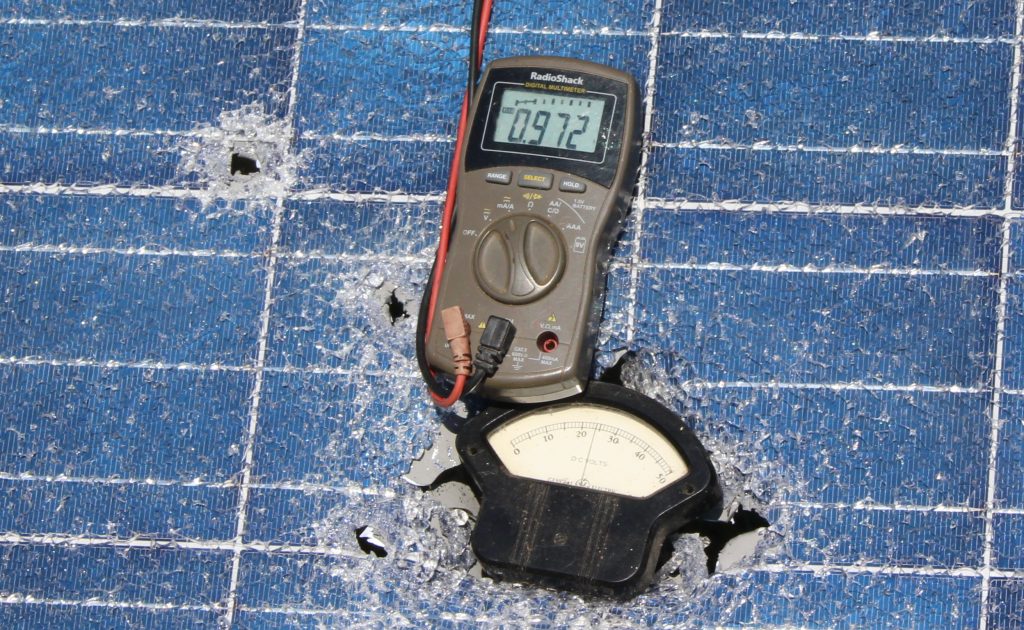What’s that black box on the back of most solar panels? Is it just a place for the wires to come out?
There are all kinds of panels, but the usual 60 or 72 cell module in an aluminum frame is going to have the black box. This is usually called the junction box. Yes, it is a handy way of getting the power out of the panel, but there is more to it.
If you have just a laminate, which John sometimes has in stock, you have the glass panel, but not the aluminum frame or the junction box. The back of the panel has a number of silver metal strips protruding and they are kind of delicate. You don’t have just a positive and a negative. Terminals inside the black box clip onto the silver strips and then the box is glued to the panel with silicone. Silicone helps keep the water out, too.
The typical panel has not one, but THREE series circuits of cells in it. There’s good reason for that. Poly or mono cells can be shut down by a single large leaf or bird splat. Sad but true. You don’t want your rooftop solar to shut down because the chimney is putting a little shadow on one of the panels do you? Of course not. So, they put three circuits in there, hoping you only lose a little power if you get a little shade.
Inside the box, there are some diodes. These are like one way valves for electricity.. They won’t let power flow backwards, but if a string within a panel is blocked or if the entire panel is blocked, power from other panels in series can use the diodes to work around the panel that can’t work and let the other panels in a string get some work done.
Usually these are not a maintenance item, but things happen. Lightning can burn out a diode. Heat can get them, too. Once in a while, like on the old solar shingles on my shed, somebody makes some poor choices and undersized diodes are used. A bad diode can cause hot spots and eventual panel failure. If you ever notice that one cell in a panel is brown or unusually hot, shut it down before it breaks. It probably has a bad diode. Fortunately, this rarely happens.
Crazy things can happen, though. I was once given a panel that had gotten too close to a tractor with a front loader bucket. (Actually, I think it was the other way around.) The story goes that the panel, fearing for its safety, leapt from the rack to the ground. In doing so, it left the cables and junction box behind. That left four shiny strips on the back of the panel. I could have just bought a new junction box. I don’t know if John has them, but numerous people sell them online on ebay. It seemed rather pointless as the glass was broken and the panel was bent, so I just soldered on some diodes that I had in the parts bin. This was not going to be installed in a system. Not even I would do something that appalling. What I did was probably worse. John and I had been having this discussion on how hard it is to destroy a solar panel. The cells, after all, are just finely sliced rocks with wires attached. He advanced the notion that you could probably punch holes in them and they’d still work.
So why not try it? There are neighborhoods in Miami where gunfire is not uncommon, but it is generally frowned upon. Not so in my neighborhood, so I got to have the fun. I proceeded to make small holes with a .45 pistol and large holes with a 12 gauge shotgun. While the power is somewhat reduced, it will still charge a battery!

It may seem that I have digressed, but back to the point of diodes in the junction box, the diodes I had tacked back onto the panel allowed the working and non working sections to work it out so that panel still had enough output to charge a battery or operate a car running light.
I am pretty sure that a shotgun blast directly into the junction box would be the end of the panel. Don’t try this at home.
And, yes, the junction box IS a handy place for the wires come out. Take note when ordering what kind of connectors are back there. MC4 is the “usual” but there are others that look similar, but won’t fit, or will fit, but not well enough for a safe connection. Be sure to order the right connectors so you won’t have the installation delayed. You don’t want the neighbors to hear you cussin’.
—Neal
